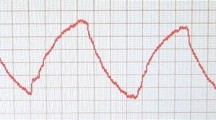Abstract
Objectives
Vertigo is a very common symptom mainly caused by the lesion of vestibular system (peripheral or central) and often accompanied by some work-related diseases and occupational intoxications. The aim of this study was to assess the value of electronystagmography (ENG) and videonystagmography (VNG) for diagnosing vertigo of various origin.
Materials and Methods
The study included four groups, 25 subjects each, of patients suffering from vestibular disorders of peripheral, central and mixed origin versus healthy controls. All were examined by means of ENG and VNG, using the bithermal caloric test with 30°C and 44°C air irrigations of the ears. The findings (frequency of induced nystagmus FRQ, its slow phase velocity SPV, canal paresis CP, directional preponderance DP, vestibular excitability VE) were analysed and compared.
Results
In all patients with vertigo due to vestibular neuritis, barotrauma and kinetosis, significant CP, the important sign of peripheral site of vestibular lesion was identified both in ENG and VNG. None of the patients with central origin disorders showed CP in VNG; in the majority of cases DP was observed. However, in ENG we found CP in 5 patients with central origin disorders. There were no essential differences between ENG and VNG in measurements of FRQ and SPV except for higher values in VNG in controls and patients with mixed vertigo.
Conclusions
The results suggest that the VNG should be recommended in preference as the valuable method to assess vertigo and to discriminate between the peripheral and the central vestibular lesions.
Similar content being viewed by others
References
Józefowicz-Korczyńska M, Łukomski M, Pajor A. Electronystagmographic evaluation of the vestibular organ condition in patients with tinnitus and cervical spine degeneration. Otolaryngol Pol 2004;58(2):349–353 [in Polish].
Olszewski J, Repetowski M. Clinical analysis of cervical vertigo patients in the own material. Otolaryngol Pol 2008;62(3): 283–287 [in Polish].
Sułkowski WJ, Kowalska S, Matyja W, Guzek W, Szymczak W, Kostrzewski P. Effects of occupational exposure to a mixture of solvents on the inner ear: a field study. Int J Occup Med Environ Health 2002;15:247–256.
Obrębowski A, ed. Standards in diagnosis and treatment of vertigo. Warszawa: Oinpharma; 2010 [in Polish].
Furman JM, Whitney SL. Central causes of dizziness. Phys Ther 2000;80(2):179–187.
Labuguen RH. Initial evaluation of vertigo. Am Fam Physic 2006;73(2):244–251.
Lempert T, Neuhauser H. Epidemiology of vertigo, migraine and vestibular migraine. J Neurol 2009;256:333–338.
British Society of Audiology. Recommended procedure. The caloric test. London: BSA; 2010.
Yin M, Ishikawa K, Wong H, Shibata Y. A clinical epidemiological study in 2169 patients with vertigo. Auris Nasus Larynx 2009;36:30–35.
Neuhauser HK, Radtke A, Von Brevern M, Lezius F, Feldmann M, Lempert T. Burden of dizziness and vertigo in the community. Arch Intern Med 2008;168:2118–2124.
Gawron W, Pośpiech L, Orendorz-Frączkowska K, Noczyńska A. Evaluation of the changes in the auditory organ and vestibular organ in patients with diabetes type 1. Otorynolaryngol 2002;1(2):119–123 [in Polish].
Janczewski G. Vertigo. Warszawa: Solvay Pharma; 2000 [in Polish].
Pierchała K. Cause analysis of vertigo and balance disorders. Bibl Prosper Ménière 1998;2(1):9–21 [in Polish].
Olszewski J, Pietkiewicz P, Miłoński J, Bielińska M. The use of VHIT (Videonystagmography Head Impulse Test) in diagnostics of semicircular canals injuries. Otolaryng Pol 2010;64(7):32–35 [in Polish].
Kenig D, Kantor I, Jurkiewicz D. Balance system evaluation in multiple sclerosis patients on the basis of videonystagmography qualitative analysis. Pol Merk Lek 2005;19(111):301–303 [in Polish].
Pepaś R, Pietkiewicz P. Olszewski J. Comparative analysis of nystagmus caloric test results with the use of ENG and VNG in healthy subjects. Aktualn Neurol 2010;10(1):51–54 [in Polish].
Olszewski J, Pietkiewicz P, Bielińska M. Concurrent ENG and VNG recording in healthy people. In: Niedzielska G, editor. 6th Conference of Audiology and Phoniatric Section of Polish Society of Otorhinolaryngologists — Head and Neck Surgeons, 2009 Jun 18–20; Lublin, Poland [in Polish].
Lightfoot GR. The origin of order effects in the results of the bi-thermal caloric test. Int J Audiol 2004;43(5):276–282.
Janczewski G, Latkowski B, eds. Otoneurology. Vol. 1–2. Warszawa: Bel Corp; 1998 [in Polish].
Jacobson GP, Newman CW, Kartush JM, eds. Handbook of balance function testing. St. Louis: (MI): Mosby Year Book; 1993.
Zapala DA, Olsholt KF, Lundy LB. A comparison of water and air caloric responses and their ability to distinguish between patients with normal and impaired ears. Ear Hear 2008;29: 585–600.
Author information
Authors and Affiliations
Corresponding author
About this article
Cite this article
Pietkiewicz, P., Pepaś, R., Sułkowski, W.J. et al. Electronystagmography versus videonystagmography in diagnosis of vertigo. IJOMEH 25, 59–65 (2012). https://doi.org/10.2478/s13382-012-0002-1
Received:
Accepted:
Published:
Issue Date:
DOI: https://doi.org/10.2478/s13382-012-0002-1



